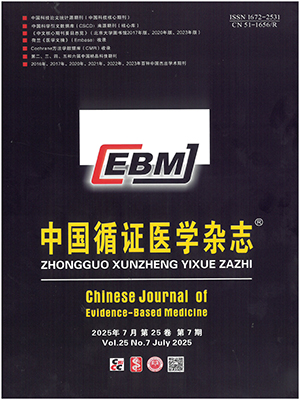| 1. |
National Cancer Institute. SEER stat fact sheets: chronic myeloid leukemia. 2020.
|
| 2. |
应江伟, 杜灵彬, 郑艳泽, 等. 浙江省肿瘤登记地区2000~2009年白血病发病与死亡分析. 中国肿瘤, 2014, 23(7): 538-542.
|
| 3. |
黄治虎, 陈宝安, 欧阳建, 等. 我国白血病流行病学调查的现状和对策. 临床血液学杂志, 2009, 22(2): 166-167.
|
| 4. |
周建军, 陈睿, 王烨菁, 等. 上海市卢湾区居民2004-2011年白血病发病和死亡资料分析. 中华肿瘤防治杂志, 2017, 24(8): 507-511.
|
| 5. |
斯垚翔, 钱虹, 刘玉琴, 等. 甘肃省2010年白血病发病和死亡分析. 中国肿瘤, 2015, 24(2): 81-88.
|
| 6. |
董金凤. 2011-2012年福建省新发成人急性白血病的发病情况调查. 福建: 福建医科大学, 2014.
|
| 7. |
刘玉琴, 赵凤菊, 陈万青, 等. 中国2009年白血病发病和死亡资料分析. 中国肿瘤, 2013, 22(7): 528-534.
|
| 8. |
赵爽, 乔文亮, 邱志新, 等. 吉非替尼治疗晚期非小细胞肺癌的药物经济学系统评价. 华西医学, 2018, 33(1): 76-83.
|
| 9. |
王莉, 胡善联, 孙鑫, 等. 卫生经济学分析的系统评价方法与挑战. 中国循证医学杂志, 2008, 8(11): 1007-1011.
|
| 10. |
Husereau D, Drummond M, Petrou S, et al. Consolidated health economic evaluation reporting standards (CHEERS) statement. Value Health, 2013, 16(2): e1-e5.
|
| 11. |
肖军, 孙谨芳, 王琦琦, 等. 卫生经济学评价报告指南及应用现状. 中华预防医学杂志, 2017, 51(3): 276-280.
|
| 12. |
Huang BT, Wang Y, Du QF, et al. Analysis of efficacy and cost-effectiveness of high-dose arabinoside versus daunorubicin chemotherapy in older adult patients with acute myeloid leukemia by cytogenetic risk profile: retrospective review from China. Int J Hematol, 2011, 93(4): 474-481.
|
| 13. |
Stein E, Xie J, Duchesneau E, et al. Cost effectiveness of midostaurin in the treatment of newly diagnosed FLT3-mutated acute myeloid Leukemia in the United States. Pharmacoeconomics, 2019, 37(2): 239-253.
|
| 14. |
Tremblay G, Dolph M, Patel S, et al. Cost-effectiveness analysis for midostaurin versus standard of care in acute myeloid leukemia in the United Kingdom. Cost Eff Resour Alloc, 2018, 16: 33.
|
| 15. |
Lambertenghi-Deliliers G, Oriani A, Pioltelli P, et al. Cost-effectiveness analysis of induction regimens containing anthracyclines in adult acute myelogenous leukemia. Leuk Lymphoma, 1991, 5(1): 33-41.
|
| 16. |
Uyl-de Groot CA, Löwenberg B, Vellenga E, et al. Cost-effectiveness and quality-of-life assessment of GM-CSF as an adjunct to intensive remission induction chemotherapy in elderly patients with acute myeloid leukemia. Br J Haematol, 1998, 100(4): 629-636.
|
| 17. |
Arenaza A, Diez R, Esteve J, et al. Cost-effectiveness of midostaurin in the treatment of acute myeloid leukemia with the FLT3 mutation in Spain. Clinicoecon Outcomes Res, 2019, 11: 683-694.
|
| 18. |
Tremblay G, Cariou C, Recher C, et al. Cost-effectiveness of midostaurin in the treatment of newly diagnosed FLT3-mutated acute myeloid leukemia in France. Eur J Health Econ, 2020, 21(4): 543-555.
|
| 19. |
Jacob LA, Aparna S, Lakshmaiah KC, et al. Decitabine compared with low-dose cytarabine for the treatment of older patients with newly diagnosed acute myeloid leukemia: a pilot study of safety, efficacy, and cost-effectiveness. Adv Hematol, 2015, 2015: 167029.
|
| 20. |
Batty N, Yin Y, Wetzler M. Decitabine is more cost effective than cytarabine and daunorubicin in elderly acute myeloid leukemia patients. Journal of Cancer Research & Therapy, 2014, 2(4): 68-73.
|
| 21. |
Coyle D, Villeneuve PJA. Economic evaluation of azacitidine in elderly patients with acute myeloid leukemia with high blast counts. Pharmacoecon Open, 2020, 4(2): 297-305.
|
| 22. |
National Institute for Health and Care Excellence. TA399-Azacitidine for treating acute myeloid leukaemia with more than 30% bone marrow blasts. 2016.
|
| 23. |
National Institute for Health and Care Excellence. TA545-Gemtuzumab ozogamicin for untreated acute myeloid leukaemia. 2018.
|
| 24. |
National Institute for Health and Care Excellence. TA552-Liposomal cytarabine–daunorubicin for untreated acute myeloid leukaemia. 2018.
|
| 25. |
National Institute for Health and Care Excellence. TA642-Gilteritinib for treating relapsed or refractory acute myeloid leukaemia. 2020.
|
| 26. |
张伶俐, 颜建周, 袁力. 阿糖胞苷分别联合伊达比星、柔红霉素治疗急性非淋巴细胞白血病成本效果的比较分析. 药学与临床研究, 2016, 24(1): 66-68.
|
| 27. |
张志萍, 朱秀美, 郭代红, 等. 急性非淋巴性白血病3种治疗方案的成本效果分析. 药物与临床, 2001, 16(2): 9-10.
|
| 28. |
郭代红, 张志萍, 朱秀美, 等. 急性非淋巴性白血病7种化疗方案的成本-效果分析. 中国药业, 2003, 12(5): 51-52.
|




